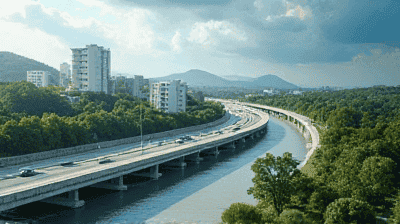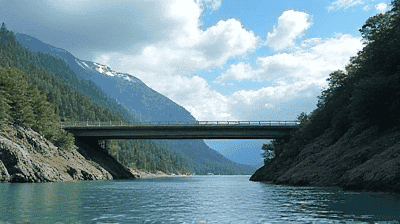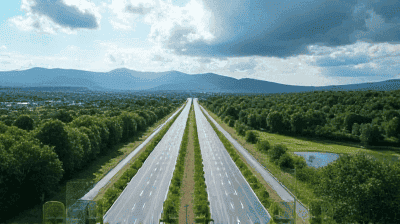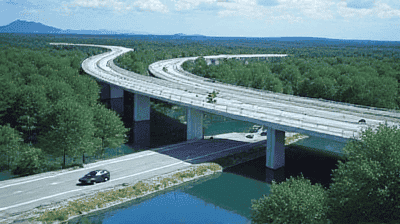
As the impacts of climate change become increasingly evident, infrastructure systems worldwide face unprecedented challenges. Severe weather events, including hurricanes, floods, heatwaves, and wildfires, are becoming more frequent and intense, threatening not only the safety of communities but also the reliability of essential transportation networks. To address these challenges, the concept of climate-resilient infrastructure, particularly in remote and vulnerable areas, has emerged as a necessity.
Infrastructure—comprising roads, bridges, railways, and utilities—forms the backbone of modern society, facilitating mobility, commerce, and communication. However, this infrastructure is increasingly vulnerable to the effects of climate change. Key considerations include:
Increased Frequency of Extreme Weather Events: Rising global temperatures contribute to the increased intensity and frequency of extreme weather phenomena, posing risks to existing transportation systems.
Rising Sea Levels: Coastal infrastructure, such as roads and bridges, faces threats from flooding and erosion caused by rising sea levels and storm surges.
Thermal Expansion: Higher temperatures can lead to material fatigue and performance issues, particularly in asphalt and concrete used in road construction.
Permafrost Thaw: In cold regions, the warming climate causes permafrost to thaw, leading to ground instability that can compromise road and bridge integrity.
Extreme weather can cause significant damage to infrastructure:
Flooding: Heavy rainfall can overwhelm drainage systems, leading to road washouts and bridge instability.
Landslides: Intense storms can trigger landslides that obstruct roads and endanger the structural integrity of bridges.
Heatwaves: Prolonged periods of extreme heat can deform road surfaces, leading to buckling and increased maintenance costs.
Winter Storms: Increased snowfall can strain snow removal efforts, while ice accumulation can render roads and bridges hazardous to travel.

Climate-remote infrastructure refers to systems designed specifically to withstand the challenges posed by climate change, particularly in remote or vulnerable regions. This approach takes into account the local climate, geography, and community needs.
Resilience: Infrastructure must be built to endure extreme weather events and continue to function under adverse conditions.
Safety: Infrastructure should prioritize the safety of users, minimizing the risk of accidents during extreme weather.
Sustainability: Building materials and construction practices should promote environmental sustainability, reducing the carbon footprint of infrastructure projects.
Adaptability: Infrastructure designs should be flexible enough to adapt to future climate scenarios and changing environmental conditions.
The first step in building climate-resilient infrastructure is thorough site assessment and selection. This involves:
Risk Mapping: Analyzing local climate data to identify potential risks, including flood zones, landslide-prone areas, and regions susceptible to extreme heat.
Geotechnical Studies: Conducting detailed studies of soil composition and stability to inform construction decisions.
Community Engagement: Involving local communities in the planning process to ensure infrastructure meets their needs and safety concerns are addressed.
Constructing elevated roads and bridges can help mitigate the impacts of flooding. Raised structures allow for the passage of water beneath them, reducing the risk of washouts and damage during heavy rainfall or storm surges.
Incorporating flexible materials into road and bridge designs can improve resilience. For example, flexible pavements can better withstand temperature fluctuations and avoid cracking or buckling.
Modular construction allows for quick and efficient repairs and replacements. In the event of damage from extreme weather, modular components can be easily swapped out, minimizing disruption and downtime.
Improving drainage systems is critical to managing stormwater and preventing flooding. Strategies include:
Permeable Pavements: Utilizing permeable materials for roads and parking areas can promote water infiltration and reduce surface runoff.
Green Infrastructure: Implementing bioswales, rain gardens, and other green infrastructure solutions can help manage stormwater while enhancing aesthetics and biodiversity.
Improved Culverts and Channels: Designing culverts and drainage channels to accommodate increased water flow during storm events ensures smoother water passage and minimizes flooding risks.
Choosing climate-resilient materials is essential for infrastructure longevity. Some options include:
Recycled Materials: Recycling materials like asphalt and concrete reduces waste and environmental impact while providing durable building components.
High-Performance Concrete: Utilizing specialized concrete mixes that are more resistant to moisture, heat, and freeze-thaw cycles can enhance the durability of roads and bridges.
Steel and Composite Materials: Selecting high-quality steel and composite materials for bridge construction can improve structural integrity and longevity.
Using technology to monitor and manage infrastructure can enhance resilience:
Sensor Technology: Implementing sensors to monitor structural integrity, humidity, temperature, and load can provide real-time data for risk assessment and maintenance decisions.
Predictive Maintenance: Utilizing data analytics for predictive maintenance can identify vulnerabilities before they result in failure, allowing for timely repairs and upgrades.
Advanced climate modeling and simulation tools can help engineers anticipate future climate scenarios and design infrastructure that stands up to various conditions.

The Netherlands is renowned for its innovative approach to flood management, incorporating climate resilience into its infrastructure:
Dikes and Flood Barriers: The Dutch have built extensive dikes and storm surge barriers to protect low-lying areas from rising sea levels and extreme storms.
Room for the River: This program involves giving rivers more space to overflow without threatening infrastructure, employing innovative designs such as floodplain restoration and levee relocation.
Norway has embraced smart infrastructure solutions to enhance resilience:
Sensor-Equipped Bridges: Norwegian bridges are increasingly equipped with sensors that monitor structural integrity and environmental conditions, providing data to facilitate timely maintenance.
Climate-Resilient Roads: The country employs robust materials and designs that can withstand extreme weather events, such as heavy snowfall and landslides.
Japan has long been a leader in designing infrastructure to withstand extreme weather and seismic events:
Flexible Bridges: Japanese bridges are designed with flexibility to absorb shocks from earthquakes and minimize damage.
Resilience Planning: Following disasters, Japan continuously enhances its disaster management plans, integrating lessons learned into infrastructure design.
Robust government policies are essential for encouraging the development of climate-resilient infrastructure:
Incentives for Resilience: Governments can provide funding incentives for infrastructure projects that demonstrate resilience to climate impacts.
Regulatory Frameworks: Establishing regulatory frameworks that prioritize climate resilience in infrastructure planning and development can guide project decisions.
Collaboration between the public and private sectors can enhance investment in climate-resilient infrastructure:
Shared Risk and Resources: Public-private partnerships (PPPs) enable shared risk and resources, fostering innovation and investment in resilient infrastructure projects.
Capacity Building: Collaborating with private firms can enhance expertise in climate-resilient design and construction techniques.
Engaging communities in planning and decision-making processes ensures that infrastructure development meets local needs:
Public Consultations: Inviting community input on infrastructure designs can enhance acceptance and ensure that projects address local concerns.
Education and Awareness: Providing education about the benefits of climate-resilient infrastructure can foster community support and participation in planning efforts.

The increasing frequency and intensity of extreme weather events demand urgent action to rethink and redesign our infrastructure systems. Climate-remote infrastructure focusing on resilience, safety, sustainability, and adaptability is essential for protecting communities from the impacts of climate change.
By leveraging innovative design approaches, advanced materials, enhanced drainage solutions, and modern technology, we can build roads and bridges that withstand extreme weather conditions. Collaborative efforts among governments, private organizations, and communities can foster the development of infrastructure capable of meeting the challenges of a changing climate.
Ultimately, investing in climate-resilient infrastructure is not just about ensuring safe transportation; it is about protecting livelihoods, promoting sustainability, and building a more resilient future for generations to come. The time to act is now, and proactive measures will play a crucial role in safeguarding infrastructure and communities in the face of climate change.